翻译术语
- 格式:docx
- 大小:40.88 KB
- 文档页数:19
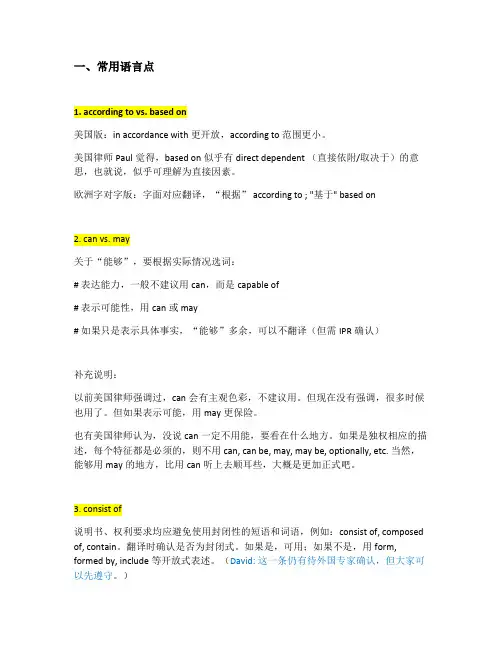
一、常用语言点1. according to vs. based on美国版:in accordance with 更开放,according to 范围更小。
美国律师Paul觉得,based on似乎有direct dependent (直接依附/取决于)的意思,也就说,似乎可理解为直接因素。
欧洲字对字版:字面对应翻译,“根据” according to ; "基于" based on2. can vs. may关于“能够”,要根据实际情况选词:# 表达能力,一般不建议用can,而是capable of# 表示可能性,用can或 may# 如果只是表示具体事实,“能够”多余,可以不翻译(但需IPR确认)补充说明:以前美国律师强调过,can会有主观色彩,不建议用。
但现在没有强调,很多时候也用了。
但如果表示可能,用may更保险。
也有美国律师认为,没说can一定不用能,要看在什么地方。
如果是独权相应的描述,每个特征都是必须的,则不用can, can be, may, may be, optionally, etc. 当然,能够用may的地方,比用can听上去顺耳些,大概是更加正式吧。
3. consist of说明书、权利要求均应避免使用封闭性的短语和词语,例如:consist of, composed of, contain。
翻译时确认是否为封闭式。
如果是,可用;如果不是,用form, formed by, include等开放式表述。
(David: 这一条仍有待外国专家确认,但大家可以先遵守。
)4. comprise说明书部分不用comprise这种法律性很强的词。
只是要用include(注:comprise 和include都属于“包括但不限于”的意思,属于开放性词语)。
5. efficient权利要求避免使用以下词语:big, sufficient, strong, such as, when required, etc. e.g.6. preferred说明书中避免使用preferred,这样会给申请本身造成一定的限制。
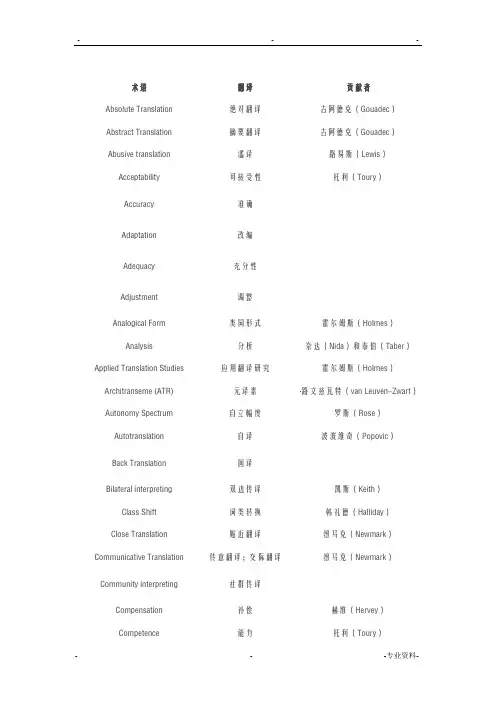
术语翻译贡献者Absolute Translation绝对翻译古阿德克(Gouadec)Abstract Translation摘要翻译古阿德克(Gouadec)Abusive translation滥译路易斯(Lewis)Acceptability可接受性托利(Toury)Accuracy准确Adaptation改编Adequacy充分性Adjustment调整Analogical Form类同形式霍尔姆斯(Holmes)Analysis分析奈达(Nida)和泰伯(Taber)Applied Translation Studies应用翻译研究霍尔姆斯(Holmes)Architranseme (ATR)元译素·路文兹瓦特(van Leuven-Zwart)Autonomy Spectrum自立幅度罗斯(Rose)Autotranslation自译波波维奇(Popovic)Back Translation回译Bilateral interpreting双边传译凯斯(Keith)Class Shift词类转换韩礼德(Halliday)Close Translation贴近翻译纽马克(Newmark)Communicative Translation传意翻译;交际翻译纽马克(Newmark)Community interpreting社群传译Compensation补偿赫维(Hervey)Competence能力托利(Toury)Componential Analysis语义成分分析奈达(Nida)Comprehensive theory综合理论Conference interpreting会议传译Consecutive interpreting接续传译Contextual consistency语境一致奈达(Nida)和泰伯(Taber)Conventions常规诺德(Nord)Corpora语料库Correspondence对应Court interpreting法庭传译Covert translation隐型翻译豪斯(House)Creative transposition创造性转换Creative treason创造性叛逆罗伯特·埃斯卡皮(Robert Escarpi)Deconstruction解构主义德里达(Derrida)Descriptive translation studies描写性翻译研究霍尔姆斯(Holmes)Differance分延德里达(Derrida)Doentary translation文献型翻译诺德(Nord)Domesticating translation归化翻译韦努狄(Venuti)Dynamic equivalence动态对等奈达(Nida)Dynamic fidelity动态忠信比克曼(Beekman)和卡洛(Callow)Effort models用功模式贾尔(Gile)Equivalence对等Excluded receiver非目标接受者皮姆(Pym)Exegetic translation诠释性翻译赫维(Hervey)和希金斯(Higgins)Exoticism异国情调赫维(Hervey)和希金斯(Higgins)Expectancy norms期待规范切斯特曼(Chesterman)Explicitation明示维纳(Vinay)和达尔贝勒纳(Darbelnet)Expressive text表情型文本赖斯(Reiss)Extraneous form外来形式霍尔姆斯(Holmes)Faithfulness忠实Foreignizing translation异化翻译韦努狄(Venuti)Formal corresponding形式对应卡特福德(Catford)Formal equivalence形式对等奈达(Nida)Free translation自由译Full translation全文翻译General theories of translation普通翻译理论霍尔姆斯(Holmes)Gist translation要旨翻译赫维(Hervey)和希金斯(Higgins)Gloss translation释词翻译奈达(Nida)Grammatical transposition语法置换赫维(Hervey)和希金斯(Higgins)Hermeneutic motion诠释步骤斯坦纳(Steiner)Hierarchy of Correspondences对应层级霍尔姆斯(Holmes)Horizontal translation横向翻译福勒纳(Folena)Hyperinformation超额信息赖斯(Reiss)和弗米尔(Vermeer)Idiomatic translation地道翻译比克曼(Beekman)和卡洛(Callow)Imitation拟译德莱顿(Dryden)、利弗威尔(Lefevere)Indeterminacy不确定性Information offer信息提供弗米尔(Vermeer)Informative texts信息文本赖斯(Reiss)Initial norms初始规范托利(Toury)Instrumental translation工具翻译诺德(Nord)Integral translation整合翻译·路文兹瓦特(van Leuven-Zwart)Interlineal translation隔行翻译赫维(Hervey)和希金斯(Higgins)Interlinear translation逐行翻译Interlingual translation语际翻译雅可布逊(Jacobson)Intersemiotic translation符际翻译雅可布逊(Jacobson)Intralingual translation语内翻译雅可布逊(Jacobson)Intra-system shift系统内转换卡特福德(Catford)Inverse translation逆向翻译Kernel sentence核心句Keyword translation关键词翻译古阿德克(Gouadec)Level shift层次转换卡特福德(Catford)Lexical translation词汇翻译卡特福德(Catford)Liaison interpreting联络传译凯斯(Keith)Linguistic translation语言翻译Literal translation字面翻译;直译Mapping图谱霍尔姆斯(Holmes)Matricial norms矩阵规范托利(Toury)Meta-language元语言霍尔姆斯(Holmes)Metatext元文本Mimetic form模仿形式霍尔姆斯(Holmes)Mutation变异·路文兹瓦特(van Leuven-Zwart)Naturalness自然性Negative shift负面转换Norms规范Obligatory equivalents必要对等语奈达(Nida)Oblique translation曲径翻译维纳(Vinay)和达尔贝勒纳(Darbelnet)Operational model操作模式巴斯盖特(Bathgate)Operational norms操作规范托利(Toury)Optional equivalents可换对等语奈达(Nida)Overlapping translation重合翻译赫维(Hervey)和希金斯(Higgins)Overt translation显型翻译豪斯(House)Overtranslation超额翻译维纳(Vinay)和达尔贝勒纳(Darbelnet)Paradigmatic equivalence范式对等波波维奇(Popovic)Paraphrase释译德莱顿(Dryden)Partial theories of translation局部翻译理论霍尔姆斯(Holmes)Participative receiver参与型接受者皮姆(Pym)Particularizing translation具体化翻译赫维(Hervey)和希金斯(Higgins)Performance运用托利(Toury)Phonemic translation音素翻译利弗威尔(Lefevere)Phonological translation音位翻译卡特福德(Catford)Pivot language中枢语言Polysystem theory多元文化理论埃文·佐哈尔(Even-Zohar)Pragmatic Approach语用途径Pragmatic translation语用翻译Preliminary norms预先规范托利(Toury)Prescriptive translation studies规定翻译研究托利(Toury)Primary translation首级翻译迪勒(Diller)和康纳留斯(Kornelius)Problem-restricted theories oftranslation 关于问题的翻译理论霍尔姆斯(Holmes)Process-oriented translation theories过程取向翻译研究霍尔姆斯(Holmes)Product-oriented translation studies成品取向翻译研究霍尔姆斯(Holmes)Professional norms翻译规范切斯特曼(Chesterman)Prospective translation前瞻式翻译波斯特盖特(Postgate)Prototext原型文本波波维奇(Popovic)Pseudotranslation伪翻译Pure language纯语言沃尔特·本雅明(Walter Benjamin)Radical translation原始翻译奎因(Quine)Rank-bound translation级阶受限翻译卡特福德(Catford)Realia独有特征弗拉科夫(Vlakhov)和弗罗林(Florin)Receptor language接受语奈达(Nida)和泰伯(Taber)Translation with reconstruction重构式翻译古阿德克(Gouadec)Redundancy冗余奈达(Nida)Refraction折射利弗威尔(Lefevere)Regulative translational conventions规约性翻译常规诺德(Nord)Relay interpreting转接传译Repertoreme知识库要素托利(Toury)Resistancy阻抗韦努狄(Venuti)Restricted translation受限翻译卡特福德(Catford)Restructuring重组奈达(Nida)和泰伯(Taber)Retrospective translation后瞻式翻译波斯特盖特(Postgate)Rewriting重写利弗威尔(Lefevere)Rhymed translation韵体翻译利弗威尔(Lefevere)Secondary translation二级翻译迪勒(Diller)和康纳留斯(Kornelius)Selective translation选译古阿德克(Gouadec)Semantic disambiguation语义消歧Semantic translation语义翻译纽马克(Newmark)Serial translation序列翻译卡塞格兰德(Casagrande)Service translation服务型翻译纽马克(Newmark)Sight translation视译Signed language translation手语传译Simultaneous interpreting同声传译Skopos theory目的论赖斯(Reiss)和弗米尔(Vermeer)Source language源语Source text源文本Source text-oriented translationstudies 源文本取向翻译研究Specification具体化Structure shift结构转换卡特福德(Catford)Stylistic equivalence文体对等Target language目标语Term banks术语库Terminology术语Text typology文本类型学Textual equivalence文本对等卡特福德(Catford)Textual norms文本规范托利(Toury)Thick translation增量翻译阿皮尔(Appiah)Think-aloud translation有声思维记录Third code第三语码弗劳利(Frawley)Time-restricted theories of translation 关于时域的翻译理论霍尔姆斯(Holmes)Total translation完全翻译卡特福德(Catford)Transcription注音Transeme译素·路文兹瓦特(van Leuven-Zwart)Transfer转移Transference迁移卡特福德(Catford)Translatability可译性Translationese翻译体Translatorial action译者行为赫尔兹·曼塔里(Justa Holz-Manttari)Transliteration音译Transposition置换维纳(Vinay)和达尔贝勒纳(Darbelnet)Unbounded translation不受限翻译卡特福德(Catford)Undertranslation欠额翻译纽马克(Newmark)Unit of translation翻译单位Universals of translation翻译普遍特征Verbal consistency词语一致Verifiability可核实性赖斯(Reiss)和弗米尔(Vermeer)Vertical translation纵向翻译福勒纳Voids空缺Whispered interpreting耳语传译Writer-oriented machine translation作者取向机器翻译。
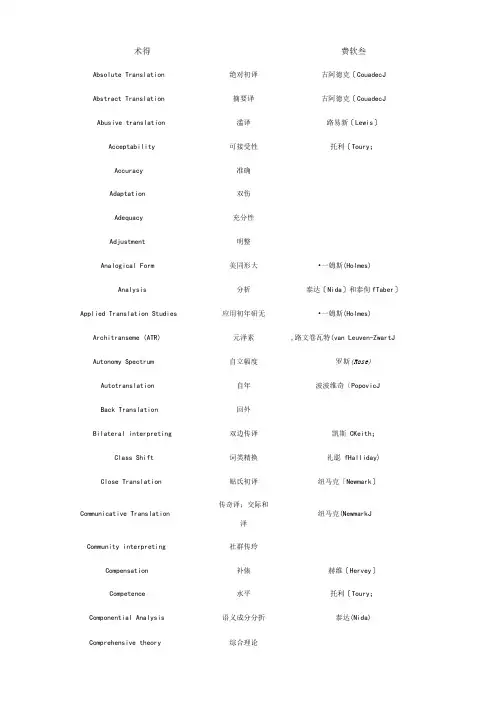
术得费软叁Absolute Translation 绝对初译古阿德克〔CouadecJ Abstract Translation 摘要译古阿德克〔CouadecJ Abusive translation 滥译路易新〔Lewis〕Acceptability 可接受性托利〔Toury;Accuracy 准确Adaptation 双伤Adequacy 充分性Adjustment 明整Analogical Form 美同形大•一姆斯(Holmes) Analysis 分析泰达〔Nida〕和泰佝fTaber〕Applied Translation Studies 应用初年研无•一姆斯(Holmes) Architranseme (ATR) 元泽素,路文卷瓦特(van Leuven-ZwartJ Autonomy Spectrum 自立幅度罗斯(Rose) Autotranslation 自年波波维奇〔PopovicJBack Translation 回外Bilateral interpreting 双边传译凯斯CKeith;Class Shift 词类精换礼聪fHalliday) Close Translation 贴氏初译纽马克「Newmark〕传奇译;交际和Communicative Translation纽马克(NewmarkJ泽Community interpreting 社群传玲Compensation 补俵赫维〔Hervey〕Competence 水平托利〔Toury;Componential Analysis 语义成分分折泰达(Nida)Comprehensive theory 综合理论Conference interpreting 会议传译Consecutive interpreting 接续传译Contextual consistency 语地一改泰达〔Nida〕和泰佝fTaber〕Conventions *规诺德〔Nord〕Corpora 语料库Correspondence 对应Court interpreting 法庭传译Covert translation 晦型译豪斯fHouse) Creative transposition 创选性转换Creative treason 创选性叛逆罗的精•埃斯卡皮〔Robert EscarpiJ Deconstruction 解构主义掠里达(Derrida)Descriptive translation studies 楮写性译研•比•一姆斯(Holmes) Diagrammatic translation 图表译古阿提克〔Couadec〕Differance 分延掠里达(Derrida) Doentary translation 文故更翻泽诺堤〔Nord〕Domesticating translation 归化译韦努狄(VenutiJ Dynamic equivalence 动杰对等鑫达(Nida)Dynamic fidelity 动杰忠信比克曼CBeekmanJ和卡洛〔Callow〕Effort models 用功模为要乐CGileJEquivalence 对等Excluded receiver 非n标接•交者皮姆(Pym)Exegetic translation 诠释性翻泽尚维fHerveyJ和希金斯fHigginsJ Exoticism 异国情*q 椅维fHerveyJ和希金斯fHigginsJ Expectancy norms 期待规切斯材受fChesterman) Explicitation 明示维纳fVinay〕和达尔贝勒纳〔DarbelnetjExpressive textExtraneous formFaithfulnessForeignizing translationFormal correspondingFormal equivalenceFree translationFull translation General theories of translation Gist translationGloss translationGrammatical transpositionHermeneutic motion Hierarchy of Correspondences Horizontal translationHyperinformationIdiomatic translationImitationIndeterminacyInformation offerInformative textsInitial normsInstrumental translationIntegral translationInterlineal translationInterlinear translation表情型文本忠实异化初年自由泽金文译普通初年理论要a译绛的译诠粹步骤对应层级横向译姆领信息地道译拟降不确定性信息提供信息文本初始规工具译整合译周行译遂行译赖斯(Reiss)农泰林斯〔Holmes〕韦努秋(VenutiJ卡耐福思〔Catford〕奈达〔Nida;笈余姆斯〔Holmesj尚维fHerveyJ和希金斯fHigginsJ奈达〔Nida;尚维fHerveyJ和希金斯fHigginsJ斯坦纳〔Steiner〕笈余姆斯〔Holmesj福勒纳CFolena)赖斯〔Reiss〕和希米尔〔Vermeer〕比克曼〔BeekmanJ和卡洛〔Callow〕掠莱顿〔Dryden人利希龙乐r Lefevere〕布米尔(VermeerJ赖斯(Reiss)托利(TouryJ诺堤〔Nord〕,路文卷瓦特(van Leuven-ZwartJ据维〔Hervey;和希金斯〔Higgins〕Interlingual translation 语际初译雅可布逊〔JacobsonJ Intersemiotic translation 符际初译雅可布逊〔JacobsonJ Intralingual translation 雅可布逊〔JacobsonJ Intra-system shift 条统转换卡林福建〔CatfordJ Inverse translation 走向译Kernel sentence 枝心勺Keyword translation 关健词翻泽古阿提克〔Couadec〕Level shift 层次精换卡特福瘪〔CatfordJ Lexical translation 词汇译卡特福瘪〔CatfordJ Liaison interpreting 麻络传译凯斯CKeith;Linguistic translation 语言译Literal translation 字而初泽;玄泽Mapping 图诺•一姆斯(Holmes) Matricial norms 矩阵规托利(TouryJMeta-language 元语言•一姆斯(Holmes) Metatext 元文本Mimetic form 模仿形大•一姆斯(Holmes) Mutation 变异,路文卷瓦特(van Leuven-ZwartJ Naturalness 自然性Negative shift 负面精换Norms 规Obligatory equivalents 必要对等语鑫达(Nida)维纳fVinayJ和达尔贝勒纳Oblique translation 曲及译〔Darbelnetj Operational model 燎作模式巴斯盖柠fBathgate〕Operational norms 掾作规托利(TouryJOptional equivalents 可换对等语泰达〔Nida;Overlapping translation 重合初年尚维fHerveyJ和希金斯(Higginsj Overt translation 星型初译豪斯〔House;Overtranslation 超额初译维纳fVinayJ和达余贝勒纳〔Darbelnetj Paradigmatic equivalence 太对等波波维奇CPopovicJ Paraphrase 村年掠茶顿(Dryden)Partial theories of translation 局部初译理论看泰姆斯〔HolmesJ Participative receiver 参与型接受者皮姆(Pym) Particularizing translation 其体化译恭维〔Hervey;和希金斯〔Higgins〕Performance 运用托利〔Toury;Phonemic translation 音素初年矛」希贰尔〔Lefevere〕Phonological translation 音伍初年卡甘福建〔CatfordJ Pivot language 中枢语言Polysystem theory 多元文化理论埃文•佐哈尔〔Even-ZoharjPragmatic Approach 语用途及Pragmatic translation 语用初年Preliminary norms 预先规托利〔Toury;Prescriptive translation studies 规定译研究托利〔Toury;Primary translation 首级初年迪勒〔Diller〕和康纳智斯fKorneliusJProblem-restricted theories oftranslation 关于问题的和年理论看泰姆斯〔HolmesJProcess-oriented translationtheories11程取向译研究府余姆斯〔HolmesJ Product-oriented translationstudies成g取向初年研究笈尔垓斯〔Holmes〕Professional norms 初泽规切斯柠史(Chesterman)Prospective translation 看赡尤翻泽波斯杵盖特CPostgateJ Prototext 原型文本波波维奇(PopovicJ Pseudotranslation 伪初泽Pure language 的语言沃余柠,本雅明^Walter Benjamin) Radical translation 原如译奎因(QuineJ Rank-bound translation 级阶受限匐译卡特福瘪(CatfordJ Realia 独有将征布拉科夫(Vlakhov)和第罗林(Florin) Receptor language 接受语泰达(Nida)和泰佝fTaber) Translation with reconstruction 重妁太翻泽古阿提克(Couadec) Redundancy 五余鑫达(Nida)Refraction 折对利布成余(Lefevere ) Regulative translational conventions 规约性初泽常规诺博(Nord) Relay interpreting 转接传书Repertoreme 知盟库要素托利(Toury;Resistancy 抗韦努狄fVenutiJ Restricted translation •更限初年卡甘福建(CatfordJ Restructuring 重姐泰达(Nida)和泰佝fTaber) Retrospective translation 后唔尤初泽波斯将盖特(Postgatej Rewriting 重写矛」希贰尔(Lefevere) Rhymed translation 韵体初年矛」希贰尔(Lefevere) Secondary translation 二级初年迪勒(Diller)和康纳智斯fKorneliusJ Selective translation 选外古阿徒克(Couadec) Semantic disambiguation 语义清故Semantic translation 语义初年纽马克(Newmark) Serial translation 序列初年卡塞格.言德(CasagrandeJService translation 效劳型翻泽纽马克〔NewmarkJSight translation 视译Signed language translation 手语传译Simultaneous interpreting 同声传译Skopos theory 〔\的论赖斯〔Reiss〕为希米尔〔Vermeer〕Source language 源语Source text 源文本Source text-oriented translationstudies 源文本取的译研无Specification 具体化Structure shift 结构转换卡甘福建〔CatfordJ Stylistic equivalence 文体对等Target languageTerm banks 术语库Terminology 术语Text typology 文本类型学Textual equivalence 文本对等卡甘福建〔CatfordJ Textual norms 文本现托利〔TouryJThick translation 增量初年阿史泰〔AppiahJThink-aloud translation 有力思维记录Third code 第三语吗弗劳利〔Frawley〕Time-restricted theories oftranslation关于时城的和年理论农泰姆斯〔HolmesJ Total translation 免全初年卡莉福鹿、〔CatfordJTranscription 注音Transeme 译素•路文卷瓦特〔van Leuven-ZwartJTransfer 转移Transference 迁移卡林福建(CatfordJTranslatability 可泽性Translationese 初泽体Translatorial action 译者行为尚东旌・曼沐里〔Justa Holz-ManttariJ Transliteration 音译Transposition 笈挨维纳fVinayJ和达尔贝勒纳(Darbelnetj Unbounded translation 不受限初泽卡甘福建(CatfordJ Undertranslation 欠领加译纽马克〔NewmarkJUn什of translation 译单位Universals of translation 匐年普遍籽征Verbal consistency 词语一致Verifiability 可核实性赖新(Reiss)和希米余(Vermeer) Vertical translation 纵向初年施勒纳Voids 全然Whispered interpreting 耳语传玲。
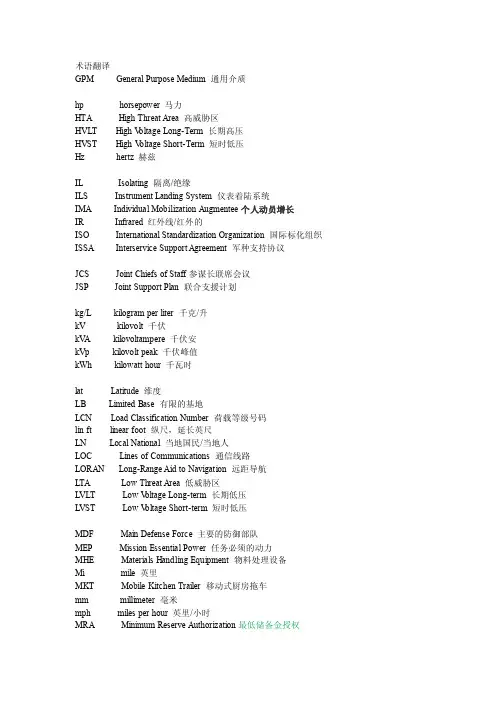
术语翻译GPM General Purpose Medium 通用介质hp horsepower 马力HTA High Threat Area 高威胁区HVLT High V oltage Long-Term 长期高压HVST High V oltage Short-Term 短时低压Hz hertz 赫兹IL Isolating 隔离/绝缘ILS Instrument Landing System 仪表着陆系统IMA Individual Mobilization Augmentee个人动员增长IR Infrared 红外线/红外的ISO International Standardization Organization 国际标化组织ISSA Interservice Support Agreement 军种支持协议JCS Joint Chiefs of Staff参谋长联席会议JSP Joint Support Plan 联合支援计划kg/L kilogram per liter 千克/升kV kilovolt 千伏kV A kilovoltampere 千伏安kVp kilovolt peak 千伏峰值kWh kilowatt hour 千瓦时lat Latitude 维度LB Limited Base 有限的基地LCN Load Classification Number 荷载等级号码lin ft linear foot 纵尺,延长英尺LN Local National 当地国民/当地人LOC Lines of Communications 通信线路LORAN Long-Range Aid to Navigation 远距导航LTA Low Threat Area 低威胁区LVLT Low V oltage Long-term 长期低压LVST Low V oltage Short-term 短时低压MDF Main Defense Force 主要的防御部队MEP Mission Essential Power 任务必须的动力MHE Materials Handling Equipment 物料处理设备Mi mile 英里MKT Mobile Kitchen Trailer 移动式厨房拖车mm millimeter 毫米mph miles per hour 英里/小时MRA Minimum Reserve Authorization最低储备金授权MSL Mean Sea Level 平均海平面MTF Medical Treatment Facility 医疗设施NBC Nuclear, Biological, and Chemical 核、生、化NCO Noncommissioned Officer 士官NCOIC Noncommissioned Officer in Charge 主管士官/值班军士NSN National Stock Number 国家库存物资编号NTA Non-Threat Area 无威胁区OIC Officer in Charge 主管官员ONC Operational Navigation Charts 作战领航图OR Operationally Ready作好战斗准备OSHA Occupational Safety and Health Administration职业安全与健康管理(局)OSI Office of Special Investigations 特别调查办公室PDC Primary Distribution Center 基层配送中心/高压配电中心PMEL Precision Measurement Equipment Laboratory精密测量设备实验室ppm parts per million 百万分之RAL Remote Area Lighting 远程大面积照明/远程区域照明RAPCON Radar Approach Control 雷达进场控制/管制RCR Runway Condition Reading跑道状况读数ROK Republic of Korea 韩国RRR Rapid Runway Repair 跑到快速维修RSC Runway Surface Condition 道面状况RSP Render-safe Procedures执行安全程序SAR Search and Rescue 搜救SBSS Standard Base Supply System (美国空军)标准基地供应系统SCNS Standard Camouflage Net System标准伪装网系统SDC Secondary Distribution Center二次配电中心,辅助配电中心,低压配电中心SME Squadron Medical Element 中队医疗分队SNCOIC Senior NCOIC 高级军士SOA Separate Operating Agency 分开的作战机构SOF Special Operations Forces特种作战部队SP Security Police 安全警察SRC Survival Recovery Center救援中心STAMP Standard Air Munitions Package标准航空弹药包STANAG Standard NA TO Agreement标准北约协议SWA Southwest Asia 西南亚TACAN Tactical Air Navigation战术空中导航TDS Total Dissolved Solids总溶解固体TLV Threshold Limit V alue 临界阈值TM Technical Manual 技术手册TO Technical Order 技术规程TOL Takeoff and Landing 起飞与着陆UMD Unit Manning Document分队人员职位配制表/分队人员配置表UTC Unit Type Code设备类型代号UXO Unexploded Ordnance未爆弹药V V olt 伏特V A voltampere 伏安V AC volts alternating current 交流电压V AL V ehicle Authorization List车辆核定表V ASI V isual Approach Slope Indicator目视进近坡度指示灯VDC volts direct current 直流电压W Watt瓦特WDR War Damage Repair 战损修复WOC Wing Operations Center 联队作战中心WRM War Reserve Materiel战争储备物资WRSK War Readiness Spares Kit战备备用套件Air Base Defense--Those measures taken to nullify or reduce the effectiveness of enemy attacks on, or sabotage of, air bases to ensure that the senior commander retains the capability to assure aircraft sortie generation.Air Force Civil Engineer Support Agency (AFCESA)--A field operating agency (FOA) located at Tyndall Air Force Base, Florida. The Directorate of Contingency Support (HQ AFCESA/CEX) acts as the Air Force program manager for Base Civil Engineer (BCE) Contingency Response Planning.空军土木工程师支援局(AFCESA)- 一个位于佛罗里达州廷德尔空军基地野战工作的机构(FOA)。
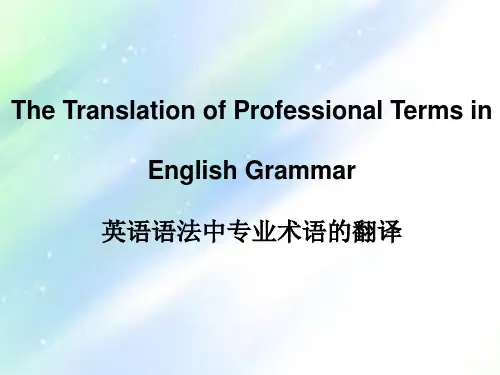
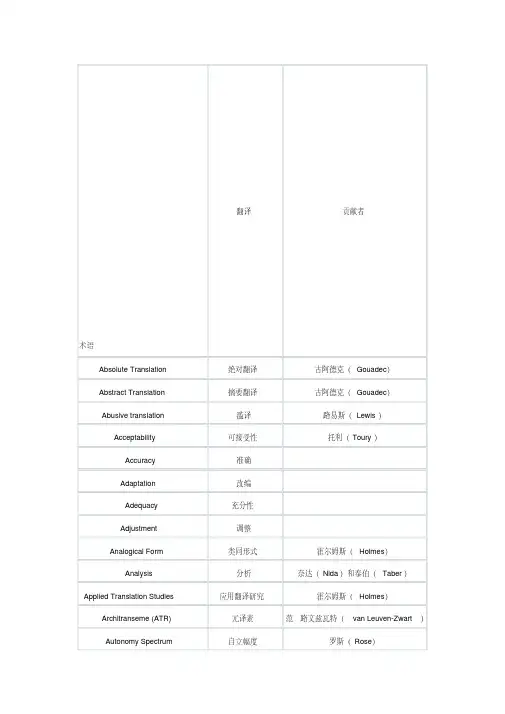
翻译贡献者术语Absolute Translation绝对翻译古阿德克(Gouadec)Abstract Translation摘要翻译古阿德克(Gouadec)Abusive translation滥译路易斯(Lewis)Acceptability可接受性托利(Toury)Accuracy准确Adaptation改编Adequacy充分性Adjustment调整Analogical Form类同形式霍尔姆斯(Holmes)Analysis分析奈达(Nida)和泰伯(Taber)Applied Translation Studies应用翻译研究霍尔姆斯(Holmes)Architranseme (ATR)元译素范·路文兹瓦特(van Leuven-Zwart)Autonomy Spectrum自立幅度罗斯(Rose)Autotranslation自译波波维奇(Popovic)Back Translation回译Bilateral interpreting双边传译凯斯(Keith)Class Shift词类转换韩礼德(Halliday)Close Translation贴近翻译纽马克(Newmark)传意翻译;交际翻Communicative Translation纽马克(Newmark)译Community interpreting社群传译Compensation补偿赫维(Hervey)Competence能力托利(Toury)Componential Analysis语义成分分析奈达(Nida)Comprehensive theory综合理论Conference interpreting会议传译Consecutive interpreting接续传译Contextual consistency语境一致奈达(Nida)和泰伯(Taber)Conventions常规诺德(Nord)Corpora语料库Correspondence对应Court interpreting法庭传译Covert translation隐型翻译豪斯(House)Creative transposition创造性转换Creative treason创造性叛逆罗伯特·埃斯卡皮(Robert Escarpi)Deconstruction解构主义德里达(Derrida)Descriptive translation描写性翻译研究霍尔姆斯(Holmes)studiesDiagrammatic translation图表翻译古阿德克(Gouadec)Differance分延德里达(Derrida)Doentary translation文献型翻译诺德(Nord)Domesticating translation归化翻译韦努狄(Venuti)Dynamic equivalence动态对等奈达(Nida)Dynamic fidelity动态忠信比克曼(Beekman)和卡洛(Callow)Effort models用功模式贾尔(Gile)Equivalence对等Excluded receiver非目标接受者皮姆(Pym)Exegetic translation诠释性翻译赫维(Hervey)和希金斯(Higgins)Exoticism异国情调赫维(Hervey)和希金斯(Higgins)Expectancy norms期待规范切斯特曼(Chesterman)维纳(Vinay)和达尔贝勒纳Explicitation明示(Darbelnet)Expressive text表情型文本赖斯(Reiss)Extraneous form外来形式霍尔姆斯(Holmes)Faithfulness忠实Foreignizing translation异化翻译韦努狄(Venuti)Formal corresponding形式对应卡特福德(Catford)Formal equivalence形式对等奈达(Nida)Free translation自由译Full translation全文翻译General theories of普通翻译理论霍尔姆斯(Holmes)translationGist translation要旨翻译赫维(Hervey)和希金斯(Higgins)Gloss translation释词翻译奈达(Nida)Grammatical transposition语法置换赫维(Hervey)和希金斯(Higgins)Hermeneutic motion诠释步骤斯坦纳(Steiner)Hierarchy of Correspondences对应层级霍尔姆斯(Holmes)Horizontal translation横向翻译福勒纳(Folena)Hyperinformation超额信息赖斯(Reiss)和弗米尔(Vermeer)Idiomatic translation地道翻译比克曼(Beekman)和卡洛(Callow)德莱顿(Dryden)、利弗威尔Imitation拟译(Lefevere)Indeterminacy不确定性Information offer信息提供弗米尔(Vermeer)Informative texts信息文本赖斯(Reiss)Initial norms初始规范托利(Toury)Instrumental translation工具翻译诺德(Nord)Integral translation整合翻译范·路文兹瓦特(van Leuven-Zwart)Interlineal translation隔行翻译赫维(Hervey)和希金斯(Higgins)Interlinear translation逐行翻译Interlingual translation语际翻译雅可布逊(Jacobson)Intersemiotic translation符际翻译雅可布逊(Jacobson)Intralingual translation语内翻译雅可布逊(Jacobson)Intra-system shift系统内转换卡特福德(Catford)Inverse translation逆向翻译Kernel sentence核心句Keyword translation关键词翻译古阿德克(Gouadec)Level shift层次转换卡特福德(Catford)Lexical translation词汇翻译卡特福德(Catford)Liaison interpreting联络传译凯斯(Keith)Linguistic translation语言翻译Literal translation字面翻译;直译Mapping图谱霍尔姆斯(Holmes)Matricial norms矩阵规范托利(Toury)Meta-language元语言霍尔姆斯(Holmes)Metatext元文本Mimetic form模仿形式霍尔姆斯(Holmes)Mutation变异范·路文兹瓦特(van Leuven-Zwart)Naturalness自然性Negative shift负面转换Norms规范Obligatory equivalents必要对等语奈达(Nida)维纳(Vinay)和达尔贝勒纳Oblique translation曲径翻译(Darbelnet)Operational model操作模式巴斯盖特(Bathgate)Operational norms操作规范托利(Toury)Optional equivalents可换对等语奈达(Nida)Overlapping translation重合翻译赫维(Hervey)和希金斯(Higgins)Overt translation显型翻译豪斯(House)维纳(Vinay)和达尔贝勒纳Overtranslation超额翻译(Darbelnet)Paradigmatic equivalence范式对等波波维奇(Popovic)Paraphrase释译德莱顿(Dryden)Partial theories of局部翻译理论霍尔姆斯(Holmes)translationParticipative receiver参与型接受者皮姆(Pym)Particularizing translation具体化翻译赫维(Hervey)和希金斯(Higgins)Performance运用托利(Toury)Phonemic translation音素翻译利弗威尔(Lefevere)Phonological translation音位翻译卡特福德(Catford)Pivot language中枢语言Polysystem theory多元文化理论埃文·佐哈尔(Even-Zohar)Pragmatic Approach语用途径Pragmatic translation语用翻译Preliminary norms预先规范托利(Toury)Prescriptive translationstudies规定翻译研究托利(Toury)Primary translation首级翻译迪勒(Diller)和康纳留斯(Kornelius)Problem-restricted theories oftranslation 关于问题的翻译理论霍尔姆斯(Holmes)Process-oriented translationtheories过程取向翻译研究霍尔姆斯(Holmes)Product-oriented translationstudies成品取向翻译研究霍尔姆斯(Holmes)Professional norms翻译规范切斯特曼(Chesterman)Prospective translation前瞻式翻译波斯特盖特(Postgate)Prototext原型文本波波维奇(Popovic)Pseudotranslation伪翻译Pure language纯语言沃尔特·本雅明(Walter Benjamin)Radical translation原始翻译奎因(Quine)Rank-bound translation级阶受限翻译卡特福德(Catford)Realia独有特征弗拉科夫(Vlakhov)和弗罗林(Florin)Receptor language接受语奈达(Nida)和泰伯(Taber)Translation with重构式翻译古阿德克(Gouadec)reconstructionRedundancy冗余奈达(Nida)Refraction折射利弗威尔(Lefevere)Regulative translational规约性翻译常规诺德(Nord)conventionsRelay interpreting转接传译Repertoreme知识库要素托利(Toury)Resistancy阻抗韦努狄(Venuti)Restricted translation受限翻译卡特福德(Catford)Restructuring重组奈达(Nida)和泰伯(Taber)Retrospective translation后瞻式翻译波斯特盖特(Postgate)Rewriting重写利弗威尔(Lefevere)Rhymed translation韵体翻译利弗威尔(Lefevere)迪勒(Diller)和康纳留斯Secondary translation二级翻译(Kornelius)Selective translation选译古阿德克(Gouadec)Semantic disambiguation语义消歧Semantic translation语义翻译纽马克(Newmark)Serial translation序列翻译卡塞格兰德(Casagrande)Service translation服务型翻译纽马克(Newmark)Sight translation视译Signed language translation手语传译Simultaneous interpreting同声传译Skopos theory目的论赖斯(Reiss)和弗米尔(Vermeer)Source language源语Source text源文本Source text-oriented translation studies 源文本取向翻译研究Specification具体化Structure shift结构转换卡特福德(Catford)Stylistic equivalence文体对等Target language目标语Term banks术语库Terminology术语Text typology文本类型学Textual equivalence文本对等卡特福德(Catford)Textual norms文本规范托利(Toury)Thick translation增量翻译阿皮尔(Appiah)Think-aloud translation有声思维记录Third code第三语码弗劳利(Frawley)Time-restricted theories oftranslation 关于时域的翻译理论霍尔姆斯(Holmes)Total translation完全翻译卡特福德(Catford)Transcription注音Transeme译素范·路文兹瓦特(van Leuven-Zwart)Transfer转移Transference迁移卡特福德(Catford)Translatability可译性Translationese翻译体Translatorial action译者行为赫尔兹·曼塔里(JustaHolz-Manttari)Transliteration音译维纳(Vinay)和达尔贝勒纳Transposition置换(Darbelnet)Unbounded translation不受限翻译卡特福德(Catford)Undertranslation欠额翻译纽马克(Newmark)Unit of translation翻译单位Universals of translation翻译普遍特征Verbal consistency词语一致Verifiability可核实性赖斯(Reiss)和弗米尔(Vermeer)Vertical translation纵向翻译福勒纳Voids空缺Whispered interpreting耳语传译。
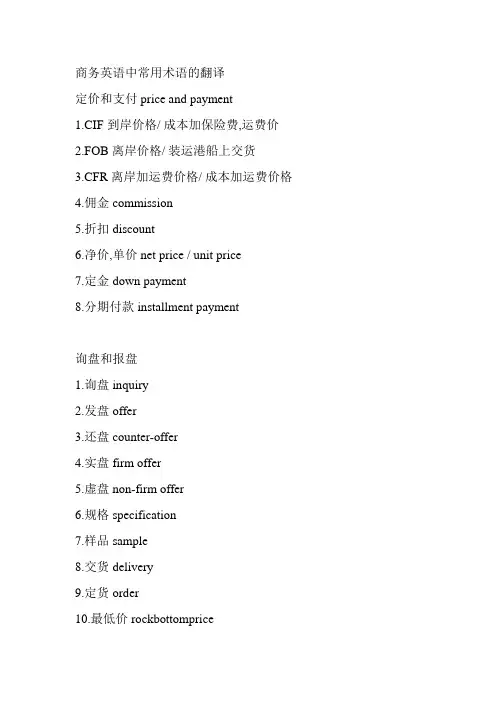
商务英语中常用术语的翻译定价和支付price and payment1.CIF 到岸价格/ 成本加保险费,运费价2.FOB离岸价格/ 装运港船上交货3.CFR离岸加运费价格/ 成本加运费价格4.佣金commission5.折扣discount6.净价,单价net price / unit price7.定金down payment8.分期付款installment payment询盘和报盘1.询盘inquiry2.发盘offer3.还盘counter-offer4.实盘firm offer5.虚盘non-firm offer6.规格specification7.样品sample8.交货delivery9.定货order10.最低价rockbottomprice11.价格单price list单据document1.形式发票proformainvoice2.商业发票commercial invoice3.领事发票consular invoice4.汇票draft / bill of exchange5.即期信用证sight draft6.远期信用证usancedraft7.信用证letter of credit / L/C8.即期信用证sight L/C9.远期信用证usanceL/C10. 装船通知shipping advice11.装箱单packing list11.货运单据shipping documents12.海运提单bill of lading / B/L13.清洁提单clean B/L14.不清洁提单unclean B/L16.保险单insurance policy17.检验证书certificate of inspection18.质检证书certificate of quality19.原产地证明书certificate of origin20.进口许可证import license21.出口许可证export license22.合同contract23.确认书confirmation24.售货确认书sales confirmation25.购货确认书confirmation of purchase。
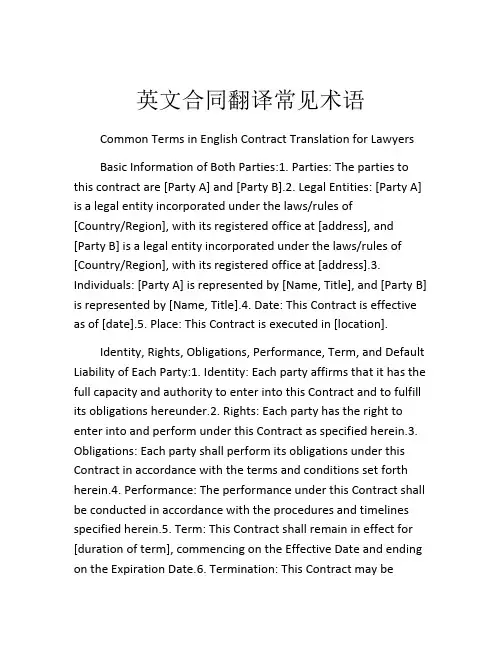
英文合同翻译常见术语Common Terms in English Contract Translation for LawyersBasic Information of Both Parties:1. Parties: The parties to this contract are [Party A] and [Party B].2. Legal Entities: [Party A] is a legal entity incorporated under the laws/rules of[Country/Region], with its registered office at [address], and [Party B] is a legal entity incorporated under the laws/rules of [Country/Region], with its registered office at [address].3. Individuals: [Party A] is represented by [Name, Title], and [Party B] is represented by [Name, Title].4. Date: This Contract is effective as of [date].5. Place: This Contract is executed in [location].Identity, Rights, Obligations, Performance, Term, and Default Liability of Each Party:1. Identity: Each party affirms that it has the full capacity and authority to enter into this Contract and to fulfill its obligations hereunder.2. Rights: Each party has the right to enter into and perform under this Contract as specified herein.3. Obligations: Each party shall perform its obligations under this Contract in accordance with the terms and conditions set forth herein.4. Performance: The performance under this Contract shall be conducted in accordance with the procedures and timelines specified herein.5. Term: This Contract shall remain in effect for [duration of term], commencing on the Effective Date and ending on the Expiration Date.6. Termination: This Contract may beterminated by either party upon [reason for termination] with [notice period].7. Default Liability: In the event of default or breach by either party of its obligations under this Contract, the non-defaulting party shall be entitled to [remedies] as specified herein.Compliance with Chinese Laws and Regulations1. The Parties shall comply with all applicable Chinese laws, regulations and policies throughout the term of this Contract.2. Each party shall be fully responsible for complying with its own legal and statutory requirements.Clarity of Rights and Obligations of Each Party:1. Each party represents and warrants that it has read and understood this Contract, and fully understands the obligations, rights and risks involved.2. Each party acknowledges and agrees that it has had the opportunity to seek advice and/or legal counsel with respect to the terms and conditions of this Contract.Legal Effectiveness and Enforceability:1. This Contract is legally binding and enforceable under the laws of[Country/Region].2. Any amendment, modification, or waiver of any provisions of this Contract shall be in writing and executed by the parties.3. This Contract contains the entire understanding between the parties and supersedes all prior negotiations, agreements and understandings between the parties.Other Terms:1. Governing Law: This Contract shall be governed by and construed under the laws of [Country/Region].2.Dispute Resolution: Any dispute arising out of or in connection with this Contract shall be resolved through arbitration in accordance with [arbitration rules], and the arbitral award shall be final and binding upon the parties.3. Counterparts: This Contract may be executed in counterparts, each of which shall be deemed an original and all of which together shall constitute one and the same instrument.This translation is made solely for reference purposes, and in case of any discrepancies between the English version and the Chinese version, the Chinese version shall prevail.。
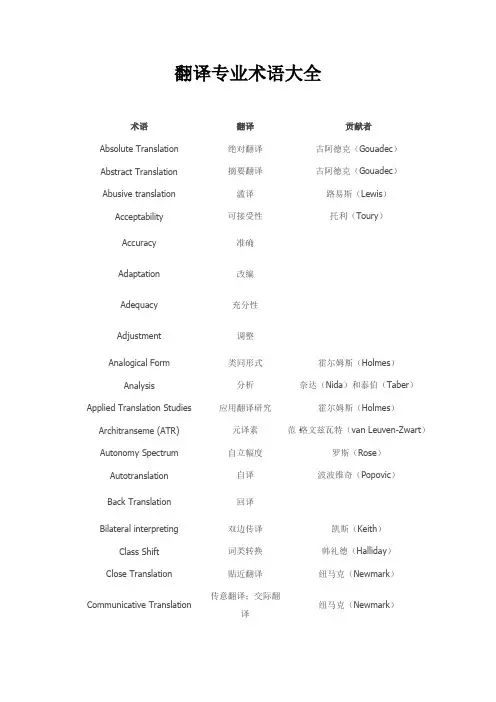
翻译专业术语大全术语翻译贡献者Absolute Translation绝对翻译古阿德克(Gouadec)Abstract Translation摘要翻译古阿德克(Gouadec)Abusive translation滥译路易斯(Lewis)Acceptability可接受性托利(Toury)Accuracy准确Adaptation改编Adequacy充分性Adjustment调整Analogical Form类同形式霍尔姆斯(Holmes)Analysis分析奈达(Nida)和泰伯(Taber)Applied Translation Studies应用翻译研究霍尔姆斯(Holmes)Architranseme (ATR)元译素范·路文兹瓦特(van Leuven-Zwart)Autonomy Spectrum自立幅度罗斯(Rose)Autotranslation自译波波维奇(Popovic)Back Translation回译Bilateral interpreting双边传译凯斯(Keith)Class Shift词类转换韩礼德(Halliday)Close Translation贴近翻译纽马克(Newmark)Communicative Translation 传意翻译;交际翻译纽马克(Newmark)Community interpreting社群传译Compensation补偿赫维(Hervey)Competence能力托利(Toury)Componential Analysis语义成分分析奈达(Nida)Comprehensive theory综合理论Conference interpreting会议传译Consecutive interpreting接续传译Contextual consistency语境一致奈达(Nida)和泰伯(Taber)Conventions常规诺德(Nord)Corpora语料库Correspondence对应Court interpreting法庭传译Covert translation隐型翻译豪斯(House)Creative transposition创造性转换Creative treason创造性叛逆罗伯特·埃斯卡皮(Robert Escarpi)Deconstruction解构主义德里达(Derrida)Descriptive translation studies描写性翻译研究霍尔姆斯(Holmes)Differance分延德里达(Derrida)Doentary translation文献型翻译诺德(Nord)Domesticating translation归化翻译韦努狄(Venuti)Dynamic equivalence动态对等奈达(Nida)Dynamic fidelity动态忠信比克曼(Beekman)和卡洛(Callow)Effort models用功模式贾尔(Gile)Excluded receiver非目标接受者皮姆(Pym)Exegetic translation诠释性翻译赫维(Hervey)和希金斯(Higgins)Exoticism异国情调赫维(Hervey)和希金斯(Higgins)Expectancy norms期待规范切斯特曼(Chesterman)Explicitation明示维纳(Vinay)和达尔贝勒纳(Darbelnet)Expressive text表情型文本赖斯(Reiss)Extraneous form外来形式霍尔姆斯(Holmes)Faithfulness忠实Foreignizing translation异化翻译韦努狄(Venuti)Formal corresponding形式对应卡特福德(Catford)Formal equivalence形式对等奈达(Nida)Free translation自由译Full translation全文翻译General theories of translation普通翻译理论霍尔姆斯(Holmes)Gist translation要旨翻译赫维(Hervey)和希金斯(Higgins)Gloss translation释词翻译奈达(Nida)Grammatical transposition语法置换赫维(Hervey)和希金斯(Higgins)Hermeneutic motion诠释步骤斯坦纳(Steiner)Hierarchy of Correspondences对应层级霍尔姆斯(Holmes)Horizontal translation横向翻译福勒纳(Folena)Hyperinformation超额信息赖斯(Reiss)和弗米尔(Vermeer)Idiomatic translation地道翻译比克曼(Beekman)和卡洛(Callow)Imitation拟译德莱顿(Dryden)、利弗威尔(Lefevere)Indeterminacy不确定性Information offer信息提供弗米尔(Vermeer)Informative texts信息文本赖斯(Reiss)Initial norms初始规范托利(Toury)Instrumental translation工具翻译诺德(Nord)Integral translation整合翻译范·路文兹瓦特(van Leuven-Zwart)Interlineal translation隔行翻译赫维(Hervey)和希金斯(Higgins)Interlinear translation逐行翻译Interlingual translation语际翻译雅可布逊(Jacobson)Intersemiotic translation符际翻译雅可布逊(Jacobson)Intralingual translation语内翻译雅可布逊(Jacobson)Intra-system shift系统内转换卡特福德(Catford)Inverse translation逆向翻译Kernel sentence核心句Keyword translation关键词翻译古阿德克(Gouadec)Level shift层次转换卡特福德(Catford)Lexical translation词汇翻译卡特福德(Catford)Liaison interpreting联络传译凯斯(Keith)Linguistic translation语言翻译Literal translation字面翻译;直译Mapping图谱霍尔姆斯(Holmes)Matricial norms矩阵规范托利(Toury)Meta-language元语言霍尔姆斯(Holmes)Metatext元文本Mimetic form模仿形式霍尔姆斯(Holmes)Mutation变异范·路文兹瓦特(van Leuven-Zwart)Naturalness自然性Negative shift负面转换Norms规范Obligatory equivalents必要对等语奈达(Nida)Oblique translation曲径翻译维纳(Vinay)和达尔贝勒纳(Darbelnet)Operational model操作模式巴斯盖特(Bathgate)Operational norms操作规范托利(Toury)Optional equivalents可换对等语奈达(Nida)Overlapping translation重合翻译赫维(Hervey)和希金斯(Higgins)Overt translation显型翻译豪斯(House)Overtranslation超额翻译维纳(Vinay)和达尔贝勒纳(Darbelnet)Paradigmatic equivalence范式对等波波维奇(Popovic)Paraphrase释译德莱顿(Dryden)Partial theories of translation局部翻译理论霍尔姆斯(Holmes)Participative receiver参与型接受者皮姆(Pym)Particularizing translation具体化翻译赫维(Hervey)和希金斯(Higgins)Performance运用托利(Toury)Phonemic translation音素翻译利弗威尔(Lefevere)Phonological translation音位翻译卡特福德(Catford)Pivot language中枢语言Polysystem theory多元文化理论埃文·佐哈尔(Even-Zohar)Pragmatic Approach语用途径Pragmatic translation语用翻译Preliminary norms预先规范托利(Toury)Prescriptive translation studies规定翻译研究托利(Toury)Primary translation首级翻译迪勒(Diller)和康纳留斯(Kornelius)Problem-restricted theories oftranslation 关于问题的翻译理论霍尔姆斯(Holmes)Process-oriented translationtheories过程取向翻译研究霍尔姆斯(Holmes)Product-oriented translationstudies成品取向翻译研究霍尔姆斯(Holmes)Professional norms翻译规范切斯特曼(Chesterman)Prospective translation前瞻式翻译波斯特盖特(Postgate)Prototext原型文本波波维奇(Popovic)Pseudotranslation伪翻译Pure language纯语言沃尔特·本雅明(Walter Benjamin)Radical translation原始翻译奎因(Quine)Rank-bound translation级阶受限翻译卡特福德(Catford)Realia独有特征弗拉科夫(Vlakhov)和弗罗林(Florin)Receptor language接受语奈达(Nida)和泰伯(Taber)Translation with reconstruction重构式翻译古阿德克(Gouadec)Redundancy冗余奈达(Nida)Refraction折射利弗威尔(Lefevere)Regulative translational规约性翻译常规诺德(Nord)conventionsRelay interpreting转接传译Repertoreme知识库要素托利(Toury)Resistancy阻抗韦努狄(Venuti)Restricted translation受限翻译卡特福德(Catford)Restructuring重组奈达(Nida)和泰伯(Taber)Retrospective translation后瞻式翻译波斯特盖特(Postgate)Rewriting重写利弗威尔(Lefevere)Rhymed translation韵体翻译利弗威尔(Lefevere)Secondary translation二级翻译迪勒(Diller)和康纳留斯(Kornelius)Selective translation选译古阿德克(Gouadec)Semantic disambiguation语义消歧Semantic translation语义翻译纽马克(Newmark)Serial translation序列翻译卡塞格兰德(Casagrande)Service translation服务型翻译纽马克(Newmark)Signed language translation手语传译Simultaneous interpreting同声传译Skopos theory目的论赖斯(Reiss)和弗米尔(Vermeer)Source language源语Source text-oriented translationstudies 源文本取向翻译研究Specification具体化Structure shift结构转换卡特福德(Catford)Stylistic equivalence文体对等Term banks术语库Terminology术语Text typology文本类型学Textual equivalence文本对等卡特福德(Catford)Textual norms文本规范托利(Toury)Thick translation增量翻译阿皮尔(Appiah)Third code第三语码弗劳利(Frawley)Time-restricted theories oftranslation 关于时域的翻译理论霍尔姆斯(Holmes)Total translation完全翻译卡特福德(Catford)Transcription注音Transeme译素范·路文兹瓦特(van Leuven-Zwart)Transfer转移Transference迁移卡特福德(Catford)Translatability可译性Translationese翻译体Translatorial action译者行为赫尔兹·曼塔里(Justa Holz-Manttari)Transliteration音译维纳(Vinay)和达尔贝勒纳Transposition置换(Darbelnet)Unbounded translation不受限翻译卡特福德(Catford)Undertranslation欠额翻译纽马克(Newmark)Unit of translation翻译单位Universals of translation翻译普遍特征Verbal consistency词语一致Verifiability可核实性赖斯(Reiss)和弗米尔(Vermeer)。
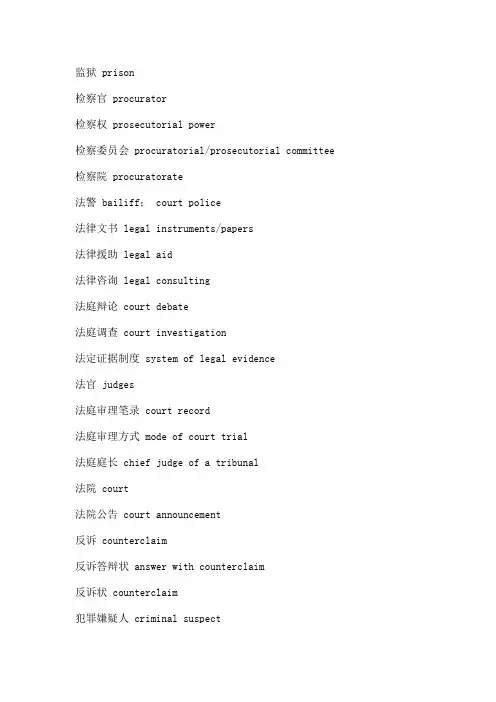
监狱 prison检察官 procurator检察权 prosecutorial power检察委员会 procuratorial/prosecutorial committee 检察院 procuratorate法警 bailiff; court police法律文书 legal instruments/papers法律援助 legal aid法律咨询 legal consulting法庭辩论 court debate法庭调查 court investigation法定证据制度 system of legal evidence法官 judges法庭审理笔录 court record法庭审理方式 mode of court trial法庭庭长 chief judge of a tribunal法院 court法院公告 court announcement反诉 counterclaim反诉答辩状 answer with counterclaim反诉状 counterclaim犯罪嫌疑人 criminal suspect附带民事诉讼案件 a collateral civil action附带民事诉讼被告 defendant of collateral civil action复查 reexamination; recheck复验 reinspect高级法官 senior judge高级检察官 senior procurator高级人民法院 Higher People's Court告诉案件 case of complaint告诉才处理的案件 case accepted at complaint告诉申诉庭 complaint and petition division工读学校 work-study school for delinquent children公安部 Ministry of Public Security公安分局 public security sub-bureau公安厅 public security bureau at the levels of provinces,autonomous regions and cities under direct jurisdiction of central government公开审理 trial in public公开审判制度 open trial system公示催告程序 procedure of public summons for exhortation公诉案件 public-prosecuting case公诉词 statement of public prosecution公证机关 public notary office共同管辖 concurrent jurisdiction管辖 jurisdiction国际司法协助 international judicial assistance海事法院 maritime court合议庭 collegial panel合议庭评议笔录 record of deliberating by the collegiate bench和解 composition; compromise核对诉讼当事人身份 check identity of litigious parties恢复执行 resumption of execution回避 withdrawal混合式诉讼 mixed action基层人民法院 basic People's Court羁押期限 term in custody级别管辖 subject matter jurisdiction of courts at different levels 监视居住 living at home under surveillance监狱 prison检察官 procurator检察权 prosecutorial power检察委员会 procuratorial/prosecutorial committee检察院 procuratorate检察院派出机构 outpost tribunal of procuratorate简易程序 summary procedure鉴定结论 expert conclusion经济审判庭 economic tribunal径行判决 direct adjudication without sessions; judgement without notice纠问式诉讼 inquisitional proceedings拘传 summon by force; summon by warrant拘留所 detention house举报 information/report of an offence举证责任 burden of proof; onus probandi决定书 decision军事法院 military procuratorate开庭审理 open a court session开庭通知 notice of court session勘验笔录 record of inquest看守所 detention house可执行财产 executable property控告式诉讼 accusatory proceedings控诉证据 incriminating evidence控诉职能 accusation function扣押 distrain on; attachment扣押物 distress/distraint宽限期 period of grace劳动争议仲裁申请书 petition for labor dispute arbitration劳改场 reform-through-labor farm劳教所 reeducation-through-labor office类推判决的核准程序 procedure for examination and approval of analogical sentence累积证据 cumulative evidence立案报告 place a case on file立案管辖 functional jurisdiction立案决定书 written decision of case-filing立案侦查 report of placing a case on file利害关系人 interested party临时裁决书 interim award律师见证书 lawyer's written attestation; lawyer's written authentication律师事务所 law office; law firm律师提前介入 prior intervention by lawyer免于刑事处分 exemption from criminal penalty民事案件 civil case民事审判庭 civil tribunal民事诉讼 civil action民事诉讼法 Civil Procedural Law扭送 seize and deliver a suspect to the police派出法庭 detached tribunal派出所 police station判决 judgement; determination判决书 judgement; determination; verdict (指陪审团作出的)旁证 circumstantial evidence陪审员 juror批准逮捕 approval of arrest破案 clear up a criminal case; solve a criminal case破产 bankruptcy; insolvency普通程序 general/ordinary procedure普通管辖 general jurisdiction企业法人破产还债程序 procedure of bankruptcy and liquidation of a business corporation起诉 filing of a lawsuit起诉 sue; litigate; prosecute; institution of proceedings上诉 appeal上诉人 appellant起诉状 indictment; information区县检察院 grassroots People's Procuratorate取保候审 the bail pending trial with restricted liberty of moving 缺席判决 default judgement人民调解委员会 People's Mediation Committee认定财产无主案件 cases concerning determination of property as qwnerless认定公民无民事行为能力、限制民事行为能力案件cases concerning determination of a citizen as incompetent or with limited disposing capacity。
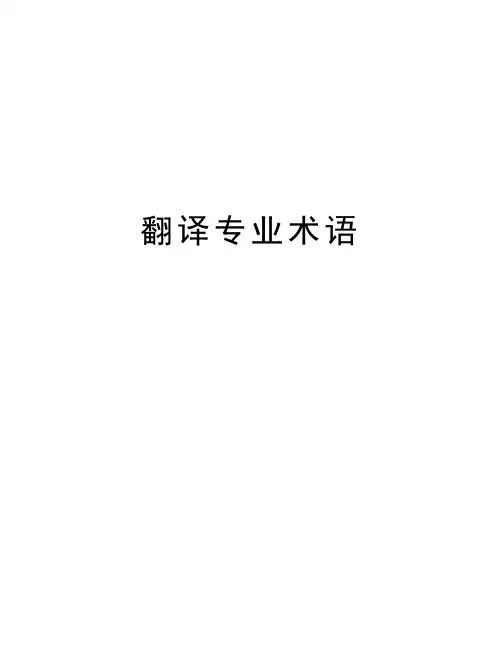
翻译专业术语术语翻译贡献者Absolute Translation绝对翻译古阿德克(Gouadec)Abstract Translation摘要翻译古阿德克(Gouadec)Abusive translation滥译路易斯(Lewis)Acceptability可接受性托利(Toury)Accuracy准确Adaptation改编Adequacy充分性Adjustment调整Analogical Form类同形式霍尔姆斯(Holmes)Analysis分析奈达(Nida)和泰伯(Taber)Applied Translation Studies应用翻译研究霍尔姆斯(Holmes)Architranseme (ATR)元译素范·路文兹瓦特(van Leuven-Zwart)Autonomy Spectrum自立幅度罗斯(Rose)Autotranslation自译波波维奇(Popovic)Back Translation回译Bilateral interpreting双边传译凯斯(Keith)Class Shift词类转换韩礼德(Halliday)Close Translation贴近翻译纽马克(Newmark)Communicative Translation 传意翻译;交际翻译纽马克(Newmark)Community interpreting社群传译Compensation补偿赫维(Hervey)Competence能力托利(Toury)Componential Analysis语义成分分析奈达(Nida)Comprehensive theory综合理论Conference interpreting会议传译Consecutive interpreting接续传译Contextual consistency语境一致奈达(Nida)和泰伯(Taber)Conventions常规诺德(Nord)Corpora语料库Correspondence对应Court interpreting法庭传译Covert translation隐型翻译豪斯(House)Creative transposition创造性转换Creative treason创造性叛逆罗伯特·埃斯卡皮(Robert Escarpi)Deconstruction解构主义德里达(Derrida)Descriptive translation studies描写性翻译研究霍尔姆斯(Holmes)Differance分延德里达(Derrida)Doentary translation文献型翻译诺德(Nord)Domesticating translation归化翻译韦努狄(Venuti)Dynamic equivalence动态对等奈达(Nida)Dynamic fidelity动态忠信比克曼(Beekman)和卡洛(Callow)Effort models用功模式贾尔(Gile)Equivalence对等Excluded receiver非目标接受者皮姆(Pym)Exegetic translation诠释性翻译赫维(Hervey)和希金斯(Higgins)Exoticism异国情调赫维(Hervey)和希金斯(Higgins)Expectancy norms期待规范切斯特曼(Chesterman)Explicitation明示维纳(Vinay)和达尔贝勒纳(Darbelnet)Expressive text表情型文本赖斯(Reiss)Extraneous form外来形式霍尔姆斯(Holmes)Faithfulness忠实Foreignizing translation异化翻译韦努狄(Venuti)Formal corresponding形式对应卡特福德(Catford)Formal equivalence形式对等奈达(Nida)Free translation自由译Full translation全文翻译General theories of translation普通翻译理论霍尔姆斯(Holmes)Gist translation要旨翻译赫维(Hervey)和希金斯(Higgins)Gloss translation释词翻译奈达(Nida)Grammatical transposition语法置换赫维(Hervey)和希金斯(Higgins)Hermeneutic motion诠释步骤斯坦纳(Steiner)Hierarchy of Correspondences对应层级霍尔姆斯(Holmes)Horizontal translation横向翻译福勒纳(Folena)Hyperinformation超额信息赖斯(Reiss)和弗米尔(Vermeer)Idiomatic translation地道翻译比克曼(Beekman)和卡洛(Callow)Imitation拟译德莱顿(Dryden)、利弗威尔(Lefevere)Indeterminacy不确定性Information offer信息提供弗米尔(Vermeer)Informative texts信息文本赖斯(Reiss)Initial norms初始规范托利(Toury)Instrumental translation工具翻译诺德(Nord)Integral translation整合翻译范·路文兹瓦特(van Leuven-Zwart)Interlineal translation隔行翻译赫维(Hervey)和希金斯(Higgins)Interlinear translation逐行翻译Interlingual translation语际翻译雅可布逊(Jacobson)Intersemiotic translation符际翻译雅可布逊(Jacobson)Intralingual translation语内翻译雅可布逊(Jacobson)Intra-system shift系统内转换卡特福德(Catford)Inverse translation逆向翻译Kernel sentence核心句Keyword translation关键词翻译古阿德克(Gouadec)Level shift层次转换卡特福德(Catford)Lexical translation词汇翻译卡特福德(Catford)Liaison interpreting联络传译凯斯(Keith)Linguistic translation语言翻译Literal translation字面翻译;直译Mapping图谱霍尔姆斯(Holmes)Matricial norms矩阵规范托利(Toury)Meta-language元语言霍尔姆斯(Holmes)Metatext元文本Mimetic form模仿形式霍尔姆斯(Holmes)Mutation变异范·路文兹瓦特(van Leuven-Zwart)Naturalness自然性Negative shift负面转换Norms规范Obligatory equivalents必要对等语奈达(Nida)Oblique translation曲径翻译维纳(Vinay)和达尔贝勒纳(Darbelnet)Operational model操作模式巴斯盖特(Bathgate)Operational norms操作规范托利(Toury)Optional equivalents可换对等语奈达(Nida)Overlapping translation重合翻译赫维(Hervey)和希金斯(Higgins)Overt translation显型翻译豪斯(House)Overtranslation超额翻译维纳(Vinay)和达尔贝勒纳(Darbelnet)Paradigmatic equivalence范式对等波波维奇(Popovic)Paraphrase释译德莱顿(Dryden)Partial theories of translation局部翻译理论霍尔姆斯(Holmes)Participative receiver参与型接受者皮姆(Pym)Particularizing translation具体化翻译赫维(Hervey)和希金斯(Higgins)Performance运用托利(Toury)Phonemic translation音素翻译利弗威尔(Lefevere)Phonological translation音位翻译卡特福德(Catford)Pivot language中枢语言Polysystem theory多元文化理论埃文·佐哈尔(Even-Zohar)Pragmatic Approach语用途径Pragmatic translation语用翻译Preliminary norms预先规范托利(Toury)Prescriptive translation studies规定翻译研究托利(Toury)Primary translation首级翻译迪勒(Diller)和康纳留斯(Kornelius)Problem-restricted theories oftranslation 关于问题的翻译理论霍尔姆斯(Holmes)Process-oriented translation 过程取向翻译研究霍尔姆斯(Holmes)theoriesProduct-oriented translationstudies成品取向翻译研究霍尔姆斯(Holmes)Professional norms翻译规范切斯特曼(Chesterman)Prospective translation前瞻式翻译波斯特盖特(Postgate)Prototext原型文本波波维奇(Popovic)Pseudotranslation伪翻译Pure language纯语言沃尔特·本雅明(Walter Benjamin)Radical translation原始翻译奎因(Quine)Rank-bound translation级阶受限翻译卡特福德(Catford)Realia独有特征弗拉科夫(Vlakhov)和弗罗林(Florin)Receptor language接受语奈达(Nida)和泰伯(Taber)Translation with reconstruction重构式翻译古阿德克(Gouadec)Redundancy冗余奈达(Nida)Refraction折射利弗威尔(Lefevere)Regulative translationalconventions规约性翻译常规诺德(Nord)Relay interpreting转接传译Repertoreme知识库要素托利(Toury)Resistancy阻抗韦努狄(Venuti)Restricted translation受限翻译卡特福德(Catford)Restructuring重组奈达(Nida)和泰伯(Taber)Retrospective translation后瞻式翻译波斯特盖特(Postgate)Rewriting重写利弗威尔(Lefevere)Rhymed translation韵体翻译利弗威尔(Lefevere)Secondary translation二级翻译迪勒(Diller)和康纳留斯(Kornelius)Selective translation选译古阿德克(Gouadec)Semantic disambiguation语义消歧Semantic translation语义翻译纽马克(Newmark)Serial translation序列翻译卡塞格兰德(Casagrande)Service translation服务型翻译纽马克(Newmark)Sight translation视译Signed language translation手语传译Simultaneous interpreting同声传译Skopos theory目的论赖斯(Reiss)和弗米尔(Vermeer)Source language源语Source text源文本Source text-oriented translationstudies 源文本取向翻译研究Specification具体化Structure shift结构转换卡特福德(Catford)Stylistic equivalence文体对等Target language目标语Term banks术语库Terminology术语Text typology文本类型学Textual equivalence文本对等卡特福德(Catford)Textual norms文本规范托利(Toury)Thick translation增量翻译阿皮尔(Appiah)Think-aloud translation有声思维记录Third code第三语码弗劳利(Frawley)Time-restricted theories oftranslation 关于时域的翻译理论霍尔姆斯(Holmes)Total translation完全翻译卡特福德(Catford)Transcription注音Transeme译素范·路文兹瓦特(van Leuven-Zwart)Transfer转移Transference迁移卡特福德(Catford)Translatability可译性Translationese翻译体Translatorial action译者行为赫尔兹·曼塔里(Justa Holz-Manttari)Transliteration音译Transposition置换维纳(Vinay)和达尔贝勒纳(Darbelnet)Unbounded translation不受限翻译卡特福德(Catford)Undertranslation欠额翻译纽马克(Newmark)Unit of translation翻译单位Universals of translation翻译普遍特征Verbal consistency词语一致Verifiability可核实性赖斯(Reiss)和弗米尔(Vermeer)Vertical translation纵向翻译福勒纳Voids空缺Whispered interpreting耳语传译Writer-oriented machine 作者取向机器翻译translation。
银行专用翻译:✧招商银行:ChinaMerchantsBank✧中国工商银行:IndustrialandCommercialBankofChina ✧中国农业银行:AgriculturalBankofChina✧花旗银行:Citibank✧中信银行:ChinaCiticBank✧交通银行:BankofCommunications✧中国光大银行:ChinaEverbrightBank✧中国建设银行:ChinaConstructionBank✧广东发展银行:GuangdongDevelopmentBank✧✧✧✧✧✧✧✧现存✧✧✧✧✧✧✧✧ATM✧✧✧✧✧✧✧✧✧客户转账:Customertransfer✧网上消费:Onlinespending/Onlineconsumption✧柜台存款:Counterdeposit✧信用卡存:Depositincreditcard✧分红:Dividendsofwealthmanagement✧还本:Principalrefundofwealthmanagement✧汇入汇款:Inwardremittance✧利息转存:Interestredeposit✧电子支付:Electronicpayment✧跨行来账:✧银联ATM:UnionpayatATM✧POS消费:POSconsumption✧转账销户:Transferandcloseanaccount✧基金认购、申购、赎回:Subscription/Purchasing/redeemingfund ✧电话费:Telephonefee✧ATM跨行费:ATMinter-bankfee✧账户结息:Interestsettlement✧柜台取现:Drawcashatcounter✧即时售汇:Instantsale✧对私提回贷:Personal✧个人售汇:PersonalsalesofFx✧转账收费:Transferfee✧手机费:Mobilephonefee✧✧✧✧✧✧✧✧✧✧✧✧✧✧✧✧✧✧ATM✧ATM✧✧✧✧✧✧✧他行汇入:Remittedacrossbank/Inwardremittancefromotherbank ✧柜面交易:Transactionoverthecounter✧换折:Renewal✧银证:Banksecurities✧汇款:Remittance✧累存:Accumulateddeposit✧累取:Accumulatedwithdrawal✧有线:Cablecharge✧公积金还贷:Funddeductedaccountofhousingloan✧扣年费:Deductionforannualfee✧报销费:Reimbursementfee✧补正:Correction✧支付通:Icardpay✧网通费:CNCfee✧抹帐:Reversinganentry✧劳务:Laborservice✧报销劳务:Reimbursementforlaborcost ✧认购:Subscription✧承上:Broughtdown✧合并:Merge✧帐服费:Smallmanagementfee✧活期账户:CurrentAccount✧✧✧✧✧✧✧✧✧✧✧✧✧✧✧✧✧✧✧✧✧。
术语翻译及术语解释汇总术语翻译1.Design features of language(语言的甄别特征)Arbitrariness(任意性),Duality(二层性/二重性),Creativity(创造性/原创性),Displacement(移位性),Cultural transmission(文化传播),Interchangeability(可互换性)2. Functions of languagereferential 指称功能poetic 诗学功能emotive情感功能conative 劝慰功能phatic寒暄功能metalingual function 元语言功能ideational function概念功能interpersonal function人际功能textual function语篇/文本功能Informative(信息/告知功能),Performative Function(施为功能),Emotive Function(情感功能),Phatic communion(寒暄交谈),Recreational Function(娱乐功能),3. Phonetics(语音学),Phonology(音系/音位学); Morphology(形态学),Syntax(句法学);Semantics(语义学),Pragmatics(语用学)Articulatory phonetics发音语音学Acoustic phonetics声学语音学Auditory phonetics听觉语音学Psycholinguistics心理语言学Sociolinguistics社会语言学Anthropological linguistics人类语言学Computational linguistics计算语言学Applied linguistics应用语言学Neurolinguistics神经语言学4. Descriptive vs. prescriptive描写式和规定式Synchronic vs. diachronic共时和历时Langue vs. parole语言和言语Competence vs. performance语言能力和语言行为5. V ocal tract 声道(resonating cavities共鸣腔),pharynx咽腔, oral cavity口腔and nasal cavity鼻腔.其它的一些发音器官:lungs肺, windpipe(trachea)气管, vocal folds声带, larynx喉, epiglottis会厌,次声门, pharynx咽, uvula小舌, hard palate硬腭,soft palate软腭, alveolar ridge齿龈6.Consonants and vowels(辅音和元音)A. Manners of articulation发音方式B. Places of articulation发音位置7. Stop (or plosive)爆破音Fricative摩擦音Approximant近似音Lateral (approximant)边音Affricates塞擦音, trill颤音and tap 闪音Bilabial双唇音Labiodental唇齿音Dental齿音Alveolar齿龈音Postal veolar后齿龈音Retroflex卷舌音Palatal硬腭音Velar软腭音Uvular小舌音, pharyngeal咽音glottal声门音monophthong vowel: 单元音diphthongs双元音triphthongs三元音Lax vowels短元音Tensed vowels长元音8.Coarticulation and phonetic transcription协同发音和标音anticipatory coarticulation先期协同发音perseverative coarticulation后滞协同发音. broad transcription宽式标音narrow transcription严式标音9. minimal pairs最小对立体Phoneme音位phonemic transcriptions音位转写phonetic transcriptions语音转写phones音子allophones音位变体complementary distribution互补分布phonetic similarity发音近似性Free variation自由变体assimilation同化regressive assimilation逆同化progressive assimilation顺同化phonological rule 音系规则Epenthesis增音binary 二分的Distinctive features区别特征Endocentric and Exocentric Constructions向心结构和离心结构subordinate and coordinate从属和并列Conceptual meaning概念意义Associative meaning:联想意义Connotative meaning内涵意义Social meaning社会意义Affective meaning情感意义Reflected meaning反射意义Collocative meaning搭配意义Thematic meaning主位意义denotation: 外延意义connotation: 内涵The referential theory:指称理论Semantic triangle语义三角Sense and reference:涵义和指称Synonymy同义关系Antonymy反义关系Hyponymy上下义关系Polysemy一词多义关系Homonymy 同音/形异意关系Dialectal synonyms 地域同义词Stylistic synonyms风格同义词Collocational synonyms搭配同义词gradable antonymy 等级反义关系cover term覆盖项Marked vs. unmarked terms标记项和非标记项complementary antonymy 互补反义关系converse antonymy 逆向反义关系homophones: 同音异义词homographs : 同形异义词complete homonyms semantic components语义部分术语解释1.Design feature的定义:the defining(最典型的,起决定作用的)properties ofhuman language that distinguish it from any animal system of communication. 2.Synchronic共时:It refers to the description of a language at some point of timein history.3.Diachronic历时:It studies the development or history of language. In otherwords, it refers to the description of a language as it changes through time .4.prescriptive规定式:A kind of linguistic s tudy aims to lay down rules for “correctand standard” behavior in using language.5.descriptive描写式: A kind of linguistic study aims to describe and analyze thelanguage people actually use.6.Arbitrariness(任意性):By saying that “language is arbitrary”, we mean thatthere is no logical connection between meaning and sound.7.Duality(二层性/二重性):it means that language is a system, which consists oftwo levels of structures, at the lower level there is the structure of sounds; at the higher level there is the structure of meaning.8.Displacement(移位性): it means that language can be used to communicateabout things that are not present in our immediate communicational context.petence语言能力:it refers to an ideal speaker’s knowledge of the underlyingsystem of rules in a language.10.Performance语言行为: it refers to the actual use of the language by a speaker ina real communicational context.ngue语言: it refers to the speaker’s understanding and knowledge of thelanguage that he speaks.12.Parole言语: it is the actual speaking of language by an individual speaker.13.Cultural transmission(文化传播):It refers to the fact that the details of thelinguistic system must be learned anew(重新,再)by each speaker. Language is not transmitted biologically from generation to generation.14.Phatic communion(寒暄交谈):it refers to ritual exchanges, exchanges that havelittle meaning but help to maintain our relationships with other people.15.Phonetics(语音学): it is the study of the characteristics of speech sounds andprovides methods for their description, classification and transcription.16.V owels元音:the sounds in the production of which no articulators come veryclose together and the air-stream passes through the vocal tract without obstruction.17.Consonants辅音:The sounds in the production of which there is an obstructionof the air-stream at some point of the vocal tract.18.Phonology: it is the study of the sound systems of languages and it is concernedwith the linguistic patterning of sounds in human languages. And it studies the way in which speakers of a language systematically use a selection of these sounds in order to express meaning.19.Phoneme音位: the smallest unit of sound in a language which can distinguish twowords.20.Allophone音位变体: it refers to the different forms of a phoneme.21.Assimilation: it is a process by which one sound takes on some or all thecharacteristics of a neighboring sound.22.Coarticulation: a kind of phonetic process in which simultaneous or overlappingarticulations are involved.plementary distribution互补分布:when two sounds never occur in thesame environment, they are in complementary distribution.24.Free variation自由变体: if two sounds occurring in the same environment do notcontrast, that is, the substitution of one for the other does not produce a different word form, but merely a different pronunciation of the same word, then the two sounds are in free variation.25.Distinctive features区别特征:A phonetic feature which distinguishes onephonological unit, especially one phoneme, from another.26.minimal pairs最小对立体----- which can be defined as pairs of words whichdiffer from each other by only one sound.27.vowel glides滑音: The vowels involving movement from one sound to anotherare called vowel glides.28.Epenthesis增音:it means a process of inserting a sound after another sound.29.Substitution relation: it refers to the relation specifically between an individualunit and others that can replace it in a given sequence.30.Endocentric construction is one whose distribution is functionally equivalent, orapproaching equivalence, to one of its constituents, which serves as the centre, or head, of the whole.31.Exocentric construction: a group of syntactically related words where none ofthem is functionally equivalent to the group as a whole, that is, there is no definable center or head inside the group32.Reference: it is the relationship between words and the objects, actions orproperties that the words stand for. It deals with the extra-linguistic relationships between words and expressions and the world they describe.(具体的物质性的东西)33.Synonymy :It refers to the sameness sense relations between words.ponential analysis :Componential analysis defines the meaning of alexical element in terms of semantic components语义部分.35.Sense: it refers to the complex system of relationships that hold between linguisticelements themselves, it is concerned only with intra-linguistic relations.(概念性的东西)36.Semantics:semantics is the study of the meaning of linguistic units, words andsentences in particular.37.Homonymy: the phenomenon that words having different meanings have the sameform, i.e., different words are identical in sound or spelling, or in both.38.Antonymy:It refers to the oppositeness sense relations between words.39.Hyponymy上下义关系:Hyponymy indicates sense inclusiveness. The upperterm in this sense relation is called superordinate上义词,and the lower terms, hyponyms下义词, members of the same class are called co-hyponyms.。
术语翻译:科技1.Signal/ radio for help 发出求救信号2.loss of communication 失联3.Frictionless/friction-free fruit 一体化产品4.Cyber security 网络安全5.Wearable gadget 可穿戴电子产品6.Closed-circuit camera 闭路摄像机7.Information sovereignty 信息主权8.Illegal gambling websites 非法赌球网站9.Mars rover 火星探测器10. MOOC(massive open online courses) 大规模网络公开课平台11. fiber cable 光纤电缆12. terabyte 万亿字节13. Mobile Power Pack 移动电源14. router 路由器15. optical mouse 光电鼠标16. manned deep-sea submersible 深海载人潜水器17. remote-sensing satellite 遥感卫星18. carrier rocket 运载火箭19. payload capability 有效载荷能力20. facial recognition system 人脸识别系统21.操作系统 operating system22.高科技园high-tech park23.工业园区industrial park24.交叉学科interdisciplinary branch of science25.电子商务认证e-business certification26. 高速宽带互联网high-speed broadband networks27. 汉字处理软件Chinese character processing software28. 人机交互 human - computer interaction29. 虚拟银行virtual bank30. 第三代移动通信系统3-G (Generation Three mobile communication system)3D printing3D打印three-dimensional printers三维打印机Additive manufacturing叠层制造additive-manufacturing machines叠层制造设备Automated Fabrication System自动成型系统Sinter烧结1 Real estate 不动产Real estate registration rules2 stock is up on Ebola drug埃博拉致药企股价暴涨3 A calculated risk 预先估计到的风险The company took a calculated risk when they put the new computer on the market.4 Per capita 人均India’s per capita is the lowest of the brics nations.5 Ball park figure 粗略估计The contractor gave us a ball park figure for the cost of repairing the new building.=ball park estimate6 The factors considered include the amount of foreign direct investment they have attracted, the concentration of corporate headquarters, technology and media power and racial diversity. 企业总部集中度7 directed credit mortgage loanInstallment 分期付款8 release the productive forces 解放生产力Let there be further release the productive forces9 National City Bank of New York 花旗银行10 global quota 全球配额lasermass production大批量生产prototypes原型件customized jobs 定制加工short production runs小批量生产foundry sand铸造用砂foundry 铸造厂sand-casting 砂模铸造cast铸造the laser-sintering printers 激光烧结打印机fuselage frames 机身骨架high-strength steel landing-gear高强钢起落架precast metal预制金属precast slaba technical tour de force技术绝活RouterTraffic 流量Security /gateway 网关Switching 交换机FirewallInterfaceTerminalCloud computingBig data经济1.mortgage loan 按揭贷款fortable Housing Project 安居工程3.a relocated unit 搬迁户4.overall rationing system 包干制parative economics 比较经济学6.black case work 暗箱操作7.A share market A股市场8.margin account 保证金帐户9.retaliatory duty 报复性关税10.e xport rebate rate 出口退税率1.shadow banking 影子银行2.hedge fund 对冲基金3.eurozone 欧元区4.Special Drawing Rights[SDR] 特别提款权5.the Hong Kong-Shanghai Stock Connect 或“throughtrain”沪港通6.lean production 精益生产7.asset price bubble 资产价格泡沫8.Abenomics 安倍经济学9.down payment 首付10.oligarch/magnate/titan/giant/tycoon 商业巨头/大亨/巨擘/寡头1.non-performing loans (NPL) 不良贷款2.letter of credit (LC) 信用证3.Doha Round 多哈回合/多边贸易谈判bor-intensive industry 劳动密集型产业5.economies of scale 规模经济6.balance sheet 资产负债表7.share price 股票价格8.share premium 股票溢价9.stakeholder 利益相关者10.r at trading 老鼠仓1. balance sheet 资产负债表2. budget deficit 预算赤字3. micro savings 小额储蓄4. TPP (Trans-Pacific Partnership Agreement) 跨太平洋伙伴关系协议5. intercontinental trade 洲际贸易6. hedge fund 对冲基金7. financial turmoil 金融动荡8. holdout creditors 拒绝债务重组的债权人9. balance allocation 差额拨款10. export subsidy 出口补贴1 deleveraging 去杠杆化2 home mortgage loan3 Office of the Comptroller of the Currency 美国货币监理署4 ETF:exchange traded fund 交易型开放式指数基金5 financial sanctions制裁6 credit-rating agency7 household debt8 duopoly 双寡头9 Asymmetric information 信息不对称10 economic performance 经济效益社会1.薪资福利compensation and benefits(按比例增加scale up)2.后勤服务logistics service3.医改方案healthcare reform package4.安居工程housing project for low-income families5.赈灾disaster relief6.弱势群体disadvantaged groups/vulnerable7.土地征用land expropriate8.社会统筹social pooling9.城乡结合部rural-urban fringe zone10.城乡一体化city and countryside integration社会保障体系social welfare system基本养老保险basic endowment insurance/ old-age insurance基本医疗保险primary medical insurance工伤保险employment injury insurance失业保险unemployment insurance生育保险maternity insurance社保基金social security funds医疗卫生服务体系medical and healthcare systems药品加成medicine markups重大疾病critical illness/disease“新农合医保体系”new rural cooperative medical care system 红包协议hongbao stipulation / anti-bribery agreement 公立医院改革public hospital reform药品不良反应ADR ( adverse drug reaction )养老金nest egg/pension医疗卫生1.quarantine n. 隔离;vt. 对……进行隔离2.paramedic n. (医疗)护理人员3.procurement n. 采购4.immunize vt. (常指通过注射疫苗)使免疫5.contingency plan 应急计划;应变计划6.age of onset 发病年龄7.be sick with…生……病8.gestation period 妊娠期;怀孕期9.vaccination campaign 疫苗注射运动10.W orld Health Assembly 世界卫生大会1.Photovoltaic 光伏Using the sun’s heat to warm or evaporate water is a far older form of gathering solar energy than using photovoltaic cells to convert sunlight directly into electricity.2.steam generation 蒸汽发电Steam is generated at the surface of water蒸汽在水的表面上产生3.cerebral palsy(麻痹) 脑瘫4.intravenous fluid 静脉注射液The 100+ bottles represent just how much intravenous fluid this man from Dhaka required .5.wealth-building program 财富建设方案(the social security crack up)6.Health insurance premiums 健康险保费收入7.Medical services at state expense 公费医疗8.Trade union 工会9. Outpatient department 门诊部10. hospitalized 住院治疗能源环保:1、原油:crude oil、oil2、天然气:natural gas、gas3、汽油:petrol、gasoline4、煤油:coal oil、kerosene5、柴油:diesel6、沥青:pitch、asphalt7、页岩气:shale gas8、水利压裂法:hydraulic fracking、hydrofracturing9、清洁空气法案:Clean Air Act10、安全饮用水法案:The Safe Drinking Water Act11、北京雾霾污染:fetid/heavy smog enveloping the capital12、单位GDP二氧化碳排放量Carbon-dioxide emissions perunit GDP13、二氧化碳及含硫排放物carbon-dioxide or sulphuremissions14、“空气末日”air-pocalypse15、零碳能源zero-carbon energy16、零和竞争zero-sum game17、有毒烟雾Noxious smog18、掠夺性开发predatory exploitation19、气候变化框架公约(UNFCCC)United NationsFramework Convention on Climate Change20、低碳经济区low-carbon economic zone21、低碳繁荣low-carbon prosperity1.IEEPA(国际节能环保协会International Energy ConservationEnvironmental Protection Association)2.energy conservation(节约能源)3.energy-efficiency(高效节能)4.ecological agriculture(生态农业)5.International Carbon-value Award(国际碳金奖)6.low-carbon transition(低碳转型)7.the United Nations Industrial Development Organization(UNIDO联合国工业发展组织)8.new and renewable energy industries(新能源及可再生能源产业)9.green building(绿色建筑)10.n ew energy auto(新能源汽车)1.售前检测PDI pre-delivery inspections2.信息主权information sovereignty3.数据流量data volume4.一卡通one card for all5.无人驾驶汽车self-driving/driverless car6.点钞机currency-counting machine7.虚拟运营商virtual carriers8.手机专利诉讼mobile patent litigation9.即时通信服务instant messaging services10.电子通行证e-permit1.五险一金:养老保险endowment insurance,失业保险unemployment insurance,工伤保险employment injury insurance,医疗保险medical insurance,生育保险maternity insurance,公积金housing accumulation funds2.处方药prescription drugs3.OPD out-patient department 门诊部4.IPD in-patient department 住院部5.MRI magnetic resonance imaging 核磁共振成像6.non-communicable disease prevention 非传染性疾病防治7.primary care 基层医疗,acute care 急症护理8.telemedicine 远距医疗,remote patient monitoring 远程病人监护munity-based healthcare system 社区医疗体系10.养老金“城乡并轨”unify the two separate pension systemsfor urban and rural residents资源消费强度the intensity of resources consuming能源消费强度energy consumption intensity碳排放强度carbon emission intensity碳强度carbon intensity氮氧化物强度NOx emission intensity二次污染物secondary pollutions水体富营养化eutrophication细颗粒物PM 2.5 fine particulate matter空气质量指数air quality index AQIOff the chart大气污染atmospheric pollution冰芯记录ice core record太阳效应solar effect紫外线ultraviolet节能energy conservation环保environmental protection环境空气质量标准environmental air quality standards加快生态文明制度的建设to speed up the building of ecological civilization system能耗energy consumption可燃冰flammable ice可替代能源alternative energy21世纪议程Agenda21联合国环境与发展大会United Nations Conference on Environment and Development环发大会首脑会议Summit Session of UNCED联合国人类居住中心UN C enter for Human Settlements中国生物多样性保护行动计划China Biological Diversity Protection Action Plan。
翻译专业术语术语翻译贝献者AbsoluteTra nslatio n 绝对翻译古阿德克(Gouadec)AbstractTra nslatio n 摘要翻译古阿德克(Gouadec)Abusivetra nslati on 滥译路易斯(Lewis)AcceptabilitP 可接受性托利(TourP)AccuracP 准确Adaptati on 改编AdequacP 充分性Adjustme nt 调整An alogicalForm 类同形式霍尔姆斯(Holmes)An alPsis 分析奈达(Nida)和泰伯(Taber)AppliedTra nslati on Studies 应用翻译研究霍尔姆斯(Holmes)Architra nseme(ATR) 元译素范路文兹瓦特(vanLeuven-Zwart Aut ono mPSpectrum 自立幅度罗斯(Rose)Autotra nslatio n 自译波波维奇(Popovic)BackTra nslatio n 回译Bilaterali nterpreti ng 双边传译凯斯(Keith )ClassShift 词类转换韩礼德(HallidaP )CloseTra nslati on 贴近翻译纽马克(Newmark )Commu nicativeTra nslatio n 传意翻译;交际翻译纽马克(Newmark )Commu nitP in terpreti ng 社群传译Compe nsati on 补偿赫维(HerveP)Compete nee 能力托利(TourP )Comp onen tialA nalPsis 语义成分分析奈达(Nida )Comprehe nsivetheorP 综合理论Conferen cei nterpret ing 会议传译Con secutive in terpreti ng 接续传译Con teGtualc on siste ncP 语境一致奈达(Nida)和泰伯(Taber)Conven ti ons 常规诺德(Nord)Corpora 语料库Corresp ondence 对应Court in terpret ing 法庭传译Coverttra nslati on 隐型翻译豪斯(House)Creativetra nspositi on 创造性转换Creativetreas on 创造性叛逆罗伯特埃斯卡皮(RobertEscarpi )Decon structi on 解构主义德里达(Derrida )Descriptivetra nslati on描写性翻译研究霍尔姆斯(Holmes )studiesDifferance 分延德里达(Derrida )Doen tarPtra nslati on 文献型翻译诺德(Nord )Domesticati ngtra nslatio n 归化翻译韦努狄(Venuti )DPn amicequivale nee 动态对等奈达(Nida )DPn amicfidelitP 动态忠信比克曼(Beekman )和卡洛(Callow )Effortmodels 用功模式贾尔(Gile)Equivale nee 对等EGcludedreceiver 非目标接受者皮姆(PPm)EGegetictra nslatio n 诠释性翻译赫维(HerveP )和希金斯(Higgins )EGoticism 异国情调赫维(HerveP )和希金斯(Higgins )EGpecta ncPno rms 期待规范切斯特曼(Chesterman )EGplicitatio n 明示维纳(VinaP)和达尔贝勒纳(Darbelnet )EGpressiveteGt 表情型文本赖斯(Reiss)。
翻译理论知识概要 第一部分:翻译术语
1. Definitions of translation
Translation can be roughly defined as a reproduction or recreation in one language of what is written or said in another language. Being a very complicated human activity, its whole picture is never easy to describe. Scholars with different academic backgrounds have attempted to define it from various perspectives.
(1). Linguistic Views on Translation Translation theorists from the linguistic school conceive of translation as a linguistic activity and some believe that translation theory is a branch of linguistics, approaching the issues of translating primarily from the viewpoint of the linguistic differences between source and target texts.
Translation may be defined as the replacement of textual material in one language (the source language) by equivalent textual material in another language (the target language). (Catford, 1965: 20).
Translating consists in reproducing in the receptor language the closest natural equivalent of the source-language message, first in terms of meaning and secondly in terms of style. (Nida & Taber,1969:12).
Translation theory derives from comparative linguistics, and within linguistics, it is mainly an aspect of semantics; all questions of semantics relate to translation theory. (Newmark, 1982 /1988:5).
(2). Cultural Views on Translation In the cultural approach, translation is regarded not only as a transfer of linguistic signs, but also as a communication of cultures, i.e. translation is an "intercultural communication"; hence the terms of "intercultural cooperation", "acculturation", and "transculturation".
Translation is a process which occurs between cultures rather than simply between languages {Shuttleworth & Cowie,1997:35).
A translator who uses a cultural approach is simply recognizing that each language contains elements which are derived from its culture (such as greetings, fixed expressions and REALIA), that every text is anchored in a specific culture, and that conventions of text production and reception vary from culture to culture (Shuttleworth & Cowie1997:35).
For truly successful translating, biculturalism is even more important than bilingualism, since words only have meanings in terms of the cultures in which they function. (Nida, 2001:82).
翻译不仅涉及语言问题,也涉及文化问题。译者不仅要了解外国的文化, 还要深入了解自己民族的文化。不仅如此, 还要不断地把两种文化加以比较, 因为真正的对等应该是在各自文化中的含义、作用、范围、感情色彩、影响等等都是相当的。翻译者必须是一个真正意义的文化人。人们会说:他必须掌握两种语言; 确实如此, 但是不了解语言当中的社会文化, 谁也无法真正掌握语言(王佐良,1989)。
(3).Literary Views on Translation Translators who hold this view believe that translation is an artistic recreation or a recreated art. Some modern Western scholars from the literary school take literary translation to be "the manipulation or rewriting of the source texts".
文学翻译的任务是要把原作中包含的一定社会生活的映象完好无损地从一种语言移注到另一种语言中, 在翻译过程中追求语言的艺术美, 再现原作的艺术性。用茅盾的话说, 是"使读者在读译文的时候能够像读原作时一样得到启发、感动和美的感受"。
语言是塑造文学形象的工具, 因而文学的形象性特征必然要在语言上表现出来。文学语言的特征, 诸如形象、生动、鲜明、含蓄、凝练、准确、风趣、幽默、辛辣、滑稽、悦耳、民族特点、地方色彩, 还有行业习语、民间的俚语、谚语等等, 都是作家根据塑造形象的需要, 从现实生活中提炼创造出来的。文学作品的艺术形式与思想内容是辩证统一的, 翻译要保存原作风格特点, 因此要求译文生动形象、形神毕肖、雅俗等同、简洁精美、词情并茂(《译学辞典》2004: 291)。
(4). Semantic Views on Translation This view focuses on the semantic equivalence between the two languages,as well expressed by Eugene Nida(1986):"Translating means translating meaning".
Translation is rendering the meaning of a text into another language in the way that the author intended the text (Newmark,1988:5).
Semantic translation: the translator attempts,within the bare syntactic and semantic constraints of the target language,to reproduce the precise contextual meaning of the author (Newmark,1982:22).
In semantic translation, greater attention is paid to rendering the author's original thought-processes in target language than to attempting to re-interpret source text in a way which the translator considers more appropriate for the target setting (Shuttleworth & Cowie,1997:151).
(5).Functional Views on Translation Functionalists believe that translation is a specific form of human action with a certain purpose, a kind of linguistic service provided to the society.Translators should take into account the needs of the client, the reader as wellas the purpose or use of the translation:
It is not the source text, or its effects on the source-text recipient, or the function assigned to it by the author, that determines the translation process, but the prospective function or purpose of the target text as determined by the initiator's, i.e.client's needs (Baker,2001:236).